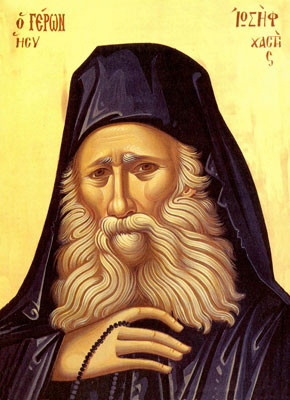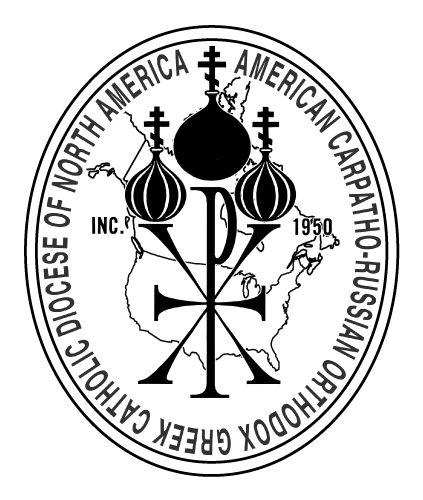Elder Joseph the Cave Dweller
1871-1959
Remember your leaders, those who spoke to you the word of God, consider the outcome of their lives and imitate their faith… (Hebrews 13:7)
 Elder Joseph the Cave Dweller, also known as Elder Joseph the Hesychast sometimes lived in a cave, sleeping on boards, died over 60 years ago yet the message of his life continues to touch Orthodox Christians around the world. He lived in a remote, desolate spot on Mount Athos in Greece but he has had a continuing impact on the spiritual renewal of the Orthodox Churches of America. His influence can be seen today here in America from the Pocono Mountains of Pennsylvania to the desert of Arizona. He has yet to be formally canonized a saint by the Ecumenical Patriarch but among his thousands of disciples he is honored as a grace-filled, miracle- working saint of our times.
Elder Joseph the Cave Dweller, also known as Elder Joseph the Hesychast sometimes lived in a cave, sleeping on boards, died over 60 years ago yet the message of his life continues to touch Orthodox Christians around the world. He lived in a remote, desolate spot on Mount Athos in Greece but he has had a continuing impact on the spiritual renewal of the Orthodox Churches of America. His influence can be seen today here in America from the Pocono Mountains of Pennsylvania to the desert of Arizona. He has yet to be formally canonized a saint by the Ecumenical Patriarch but among his thousands of disciples he is honored as a grace-filled, miracle- working saint of our times.
His Early Life
Elder Joseph was born on the Greek island of Paros with the name Francis and lived with his pious parents and six siblings in a two- room home. When he was in the fourth grade his father died forcing him to quit school to support his mother and family. He found work in Athens first as a cook, then on a trolley car and at the age of 18 enlisted in the Greek Navy, completing his compulsory military service. He became somewhat successful running a small business with a bright future ahead of him until one night he had a vivid dream. He dreamt of a beautiful palace beyond description with a voice that told him “From now on you will serve here”. As he wrestled with the meaning of this profound experience he lost interest in becoming a successful business man. Seeing his troubled soul, friends lent him a book of the Lives of Saints. Francis devoured the stories, astonished that such grace-filled and miracle-working people actually existed. He began to devote his time to prayer and fasting, giving away his resources to the poor and needy. “What do I want money and the business for? It would be better if I grew spiritually rich”.
To The Holy Mountain
Francis made his way to Mount Athos, “the Holy Mountain”, a peninsula in northeastern Greece that is the home for over 1,000 years of 20 major monasteries and numerous small sketes and hermitages. His desired to find elders and teachers who could guide him in living like the Saints he read about. His desire was to learn to overcome his sinful passions, to pray with attentiveness and zeal in order to be fully united with God. He later wrote:
On Mount Athos, we see monks who are doing well and those who are not…The monastic life does not consist of simply leaving the world and coming to Mount Athos and becoming a monk. That is easy to do. What is of essential importance is to find an elder who will teach us how the grace of God is obtained, how it is found, how it is dug up, and how this pear of great price is revealed…I was looking to find where there is life, where I could benefit my soul.
Francis traveled the length and breadth of the peninsula seeking spiritual guides to whom he could commit his soul. He met men full of the grace of the Holy Spirit: one whose room became full of a heavenly fragrance whenever he prayed, another who took hours to celebrate the Divine Liturgy due to his endless weeping, another was a blind 95 year old monk who was clairvoyant. In 1923 Francis settled under obedience to a holy monk Elder Ephraim the Barrel-maker. After his commitment to the monastic life was tested, Francis was tonsured a monk in 1925 in the cave-church of St. Athanasius receiving the name “Joseph”.
Joseph The Hesychast
Elder Ephraim and the other holy men Joseph encountered were men who had spiritual experience not from reading books but from a life of prayer, fasting and spiritual warfare. They instructed the young Joseph to constantly repeat the Jesus Prayer: “Lord Jesus Christ, have mercy on me”. This prayer, also known as “The Prayer of the Heart” is used to fulfill the commandment of the Blessed Apostle Paul who said that we are to “Pray without ceasing”. (1 Thessalonians 5:17) The elders taught Joseph to say the prayer with the mind “descending into the heart”, in other words to repeat it with concentration, from the heart, with a burning love for the Lord. As he labored day and night to constantly repeat the prayer he was blessed by a miraculous occurrence: he was granted a vision to see the Uncreated Light of God that the Apostles witnessed at the Transfiguration of our Lord. The “Prayer of the Heart” was no longer something he had to force and struggle to say but it seemed to become a very part of his being.
At once I was completely changed and forgot myself. I was filled with light in my heart and outside and everywhere, not being aware that I even had a body. The prayer began to say itself within me….
All was not light and joy for Joseph. Despite the fact that he remained sexually pure his entire life he was attacked ferociously by lustful thoughts. He struggled to control his temper and realized how quickly he could be filled with anger and rage. In one of his letters he wrote:
If I wanted to relate everything I went through on a daily basis with this passion of anger, I would have to write a book. Since God wanted to free me from it, He would bring about everything appropriate: people would bother me unjustly, they would insult me, they would annoy me. And they would not just simply tempt me, but they would do things that would make you commit murder. But by enduring and choking Satan within me with extreme patience, I was delivered from the evil.
This practice of seeking freedom from the passions, acquiring attention, stillness, quiet and entering into prayer in order to achieve complete union with God is known as hesychasm from the Greek word which means “stillness, rest, quiet, silence”. Elder Joseph is one of the most recent examples of a hesychast: one who practices hesychasm. Many of the great saints throughout history witness to this practice and affirm that the Christian Faith is not simply a routine or a habit but must be a personal experience of the living Christ. Like Elder Joseph, holy men like St. Gregory Palamas and St. Symeon the New Theologian taught that we cannot experience God through education, philosophy, intellectual discussion and debates. God is a person with whom we are to be in a relationship, not a topic to be discussed or facts to memorize. They taught that God desires that we know Him, to experience Him, to share His life, to become one with Him. St. Gregory Palamas and St. Symeon the New Theologian spoke of the Christian Faith not as rules, commandments and rituals but a way of life leads to a living union Jesus. St. Symeon said:
"Do not say that it is impossible to receive the Spirit of God. Do not say that it is possible to be made whole without Him. Do not say that one can possess Him without knowing it. Do not say that God does not manifest Himself to man. Do not say that men cannot perceive the divine light, or that it is impossible in this age! Never is it found to be impossible, my friends. On the contrary, it is entirely possible when one desires it" (Hymn 27, 125-132).
Elder Joseph lived over 1,000 years after St. Gregory and St. Symeon but his life is evidence that the spiritual path of the grace-filled saints of old is still possible today.
His Influence
Elder Joseph, despite the austerity of the lifestyle and remote location, attracted disciples seeking the same experience of life-giving light from Christ. His disciples revitalized many of the monasteries of Mount Athos that had been in a state of decline: Philotheou, Xeropotamou, Karakallou and others throughout Greece. One of his disciples, Father Ephraim, lived in obedience to Elder Joseph for twelve years and became the abbot of Philotheou Monastery in 1973. In 1979 Father Ephraim came to Canada for needed surgery and after visiting the United States he recognized the spiritual hunger that existed among the Orthodox Christians of North America. He began traveling the length and breadth of the continent establishing sixteen monasteries for men and women in places such as Saxonburg and White Haven in Pennsylvania, Roscoe New York and his main monastery in Florence, Arizona where he lives to this day. These monasteries are bursting at the seams with young men and women who are seeking the authentic Orthodox spiritual life of battling the sinful passions and union with God. While some accuse Father Ephraim of being a cult-like guru, he has brought to America the spiritual path of Mount Athos in the way of his elder – Joseph the Hesychast and of St. Gregory Palamas and St. Symeon the New Theologian. The spiritual path of Elder Joseph the Hesychast and his disciple Elder Ephraim of Arizona is a challenge and a rebuke to the lukewarm, compromised Orthodoxy sometimes present in American Orthodox parishes today.
- Father Edward Pehanich

